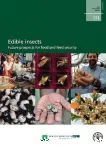Adresse
Infodoc : Réseau des bibliothèques et centres de documentation d'AgroParisTechFrance
contact
Array
(
[TITRE] => <b>Type de document : </b>
[TITRE_CLEAN] => Type de document
[OPAC_SHOW] => 1
[TYPE] => list
[AFF] => Livre
[ID] => 4
[NAME] => cp_typdoc
[DATATYPE] => integer
[VALUES] => Array
(
[0] => 5
)
)

| Titre : |
Edible insects : future prospects for food and feed security
|
| Auteur(s) : |
Arnold Van Huis
Joost Van Itterbeeck Harmke Klunder Esther Mertens Afton Halloran Giulia Muir Paul Vantomme |
| Type de document : | Livre |
| Sujets : | INSECTE ; CONSOMMATION ; SECURITE ; SANTE ; ELEVAGE ; ALIMENT POUR ANIMAUX ; NUTRITION ; VALEUR NUTRITIVE ; CONSERVATION |
| Editeur(s) : | Rome : Food and Agriculture Organization of the United Nations (FAO) |
| Date de publication : | 2013 |
| Collection : | FAO Forestry paper, num. 171 |
| Format : | 1 vol. (XVI-187 p.) / ill. en coul., couv. ill. en coul. / 30 cm |
| Note(s) : |
Bibliogr. p. 163-187 |
| Table des matières : |
1. Introduction
1. Introduction |
| Langue(s) : | Anglais |
| Identifiant : | 978-92-5-107595-1 |
| Lien vers la notice : | https://infodoc.agroparistech.fr/index.php?lvl=notice_display&id=166401 |
Exemplaires (1)
| Localisation | Emplacement | Pôle | Section | Cote | Support | Disponibilité |
|---|---|---|---|---|---|---|
| Palaiseau | Vert | TU Aliments - Cosmétiques - Biomatériaux | TU5.101 VAN | Papier | Empruntable Disponible |




